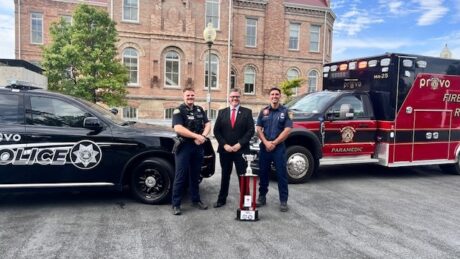EveryDay Strong: Kids feel alone — here’s what you can do about that
- Kids need to feel connected on individual, family and community levels.
- Greg Hudnall

Courtesy photo
Kids need to feel connected on individual, family and community levels.
I have overseen a volunteer crisis team for the past 15 years within Utah.
If there’s a suicide or a shooting in a school, or a community needs help, they’ll fly our team out. I’ve been involved with close to 55 youth suicides either as a first responder or as a consultant.
In about 18 to 20 percent of the cases, the young person leaves a note. I’ve been able to read and review a lot of those notes. Interestingly enough, it usually starts out by saying, “Mom, Dad, don’t blame yourself; this is not your fault.” But then, invariably, there’s a section where the person describes how they feel all alone, that no one understands what they’re going through.
After that, everyone’s story is different, but it’s the commonality — that sense that all of these young people feel so alone — that sticks with me.
Back in the ’90s, when I first started doing this work, we came up with a mantra that while it takes an entire village to raise a child, we believe it takes an entire community to save one. Feeling that you’re connected — that you’re not alone — is so important.

Courtesy photo
Greg Hudnall
In fact, in order to do something about this terrible feeling of loneliness that so many people have, I believe you need three things: individual connectedness, family connectedness and community connectedness.
Individual connection
As a high school principal, I saw the kids who belong to something felt empowered. It didn’t matter what it was — performing arts, music, sports, chess club or ski club. They had someone that cared about them and they cared about others.
In fact, I was the hearing officer for Provo School District for 15 years. When a child had been suspended, they would come to my office for a further hearing. We would sit in the meetings with administrators, social works, school psychologists, the principal and the family.
In many of those situations, I got to meet one-on-one with the child and ask them, “Give me the names of two of your friends at school? Who’s your best friend at school?” Invariably, it was fascinating to watch these young people hesitate and finally come up with, “Well, I guess there’s Johnny ….” And then I would ask, “What’s Johnny’s last name? Where does Johnny live? What does Johnny like to do?” And they never knew the answer. Johnny wasn’t a friend. Johnny was a classmate.
Time and time again, I saw these young people who were acting out because they were suffering. They were hurting; they were turning to things to fill that void, to try to belong. Young people need to feel connected to someone. I encourage parents to help their child find something they are passionate about to help them belong to something.
Family connection
One of the protective factors in preventing suicide, depression and other things is having one meal together a day as a family. It doesn’t matter if it’s breakfast, lunch or dinner, but take time to put away all electronics, turn off the television and be together.
Then you want to take time to ask questions and interact with your child. How was your day at school? What are you going to do today? And then really listen. Listen more than you talk. Too many young people share with me that, “My parents do not listen to what I am really trying to say. They try to fix everything without really understanding what I am going through.”
Or, ask them their opinion on topics, whether it’s politics, whether it’s religion — the topic doesn’t matter as much as teaching your child that what she has to say has value and that she is important. That sort of validation and confidence building starts within the home.
Parents can also model the value of friendship for their children by having close friends themselves. As adults, we can role model positive relationships with peers by being seen by our children interacting and participating with other adults in a positive way, whether it’s at church, a ball game or going out with friends.
Community connection
One example of how to be involved as a community is what we tried at my church. We went through and got the name and photograph of every single young person in our congregation. Then they wrote a small paragraph about that young person; for example, I’m Katie, and I love rock climbing; or I’m Kayden, and I want to be an astronaut when I grow up.
We collected all of those, put them in a book and then met with all of the adults and passed them out. We asked the adults to memorize the names of every young person, and then, when they passed them in the hallway, to greet them by name, and ask, “Hey, Lauren, how’s the soccer team?”
All of a sudden, there’s a visual, emotional and physical connection. And not only did the kids feel more connected to the adults — it was fascinating to see the adults felt more connected to the kids because they knew more about them.
You don’t have to belong to a religious community to try something like this out. The key is finding ways to help your children connect with the community.
Connection is a human need
I am frightened by the number of young people who share with me that they “feel all alone” and wish they had someone to talk to. I see hundreds of kids walking through school hallways with no smile and feeling like no one cares about them. It is amazing the power one person has to make a difference in the life of another person. It’s why the Hope Squad is such an important piece of community-wide suicide prevention.
A colleague of mine once told me you can have 100 students who are referred to the school counselor for suicide ideation, and 97 of those 100 would never need to be seen by a therapist if they had a friend to talk to, someone who believed in them or someone who was willing to listen to them. We can never underestimate the value of belonging or being connected to someone.
As a community, we have the ability to do more to help others. I am amazed at the opportunities available to help someone else. It may be a smile, it may be sitting with someone at lunch who is all alone. Our fast-paced, self-serving culture has turned us away instead of into that person we see.
I challenge myself every day to try to do something to impact a fellow human being, whether it’s opening a door, helping someone with their groceries or just smiling and saying hi. I would like you, as a reader, to see what you could do today to connect with someone else in our community. It may be difficult and even challenging, but I promise it will be worth it.
Written by Greg Hudnall on behalf of United Way of Utah County. Hudnall is an EveryDay Strong partner, former high school principal, community advocate and founder of Hope 4 Utah, also known as Hope Squads. Originally published at www.heraldextra.com on April 8, 2018.




